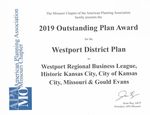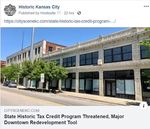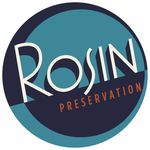Historic Kansas City Gazette
←
→
Page content transcription
If your browser does not render page correctly, please read the page content below
Historic Kansas City Gazette ~ FALL 2019
W estport Im pl em entation Begins
Implementation of the Westport District Master Plan
begins with an amendment, by Resolution, to the
Midtown Plaza Area Plan (MPAP). In effect, the
Westport Plan will become a sub-area, similar to the
Plaza Plan, becoming the policy plan for guiding
future land use, zoning and character decisions. Public
adoption process dates:
CPC November 19th at 9 am
Neighborhood, Planning & Develpment
Committee - December 4th at 1:30 pm
Much more work to follow. See the Plan & learn about
HKC's efforts here.
West port Plan Wins A ward!
The Westport District Master Plan received the 2019
American Planning Association (APA) Missouri
Chapter’s Outstanding Plan Award. The neighborhood
plan was led by Gould Evans and supported by
Historic Kansas City, the Westport Regional Business
League, and the City of Kansas City. The Westport
District Master Plan was the first plan in nearly 50
years to provide more definition and specifics of what
this historic neighborhood needs to encourage future
development, preserve its pedestrian-friendly
character, and continue to thrive as the most
authentically walkable area of Kansas City.
Congratulations to all HKC members who generously
gave their time to this effort!
HIST ORIC 9T H ST REET M OV EABLE FEASTThe fundraiser was a magical night on a quintessential KC streetscape with remarkable buildings, delicious food
and drinks by The Savoy! The Historic 9th Street tour included three Feast Destination sites: the Savoy/21c Hotel,
Kansas City Club, and New York Life Building. Professionals associated with each site guided the way.
Information about eleven additional corridor buildings was also shared. The tour concluded with a raffle
drawing at the Savoy/21c Hotel. VIP ticket holders concluded the evening in the Presidential Suite of the 21c
Hotel, including rooftop deck, with dessert and after dinner drinks.
Thank You To Our Host Sponsors
The KC Club and Epoch Developments
The 21c Hotel/Savoy
The Dioceses of Kansas City-St. Joseph
And a special thank you to our tour guides.
Professional firms who generously gave their time to share stories about each historic property.The Historic West Ninth Street & Baltimore Avenue area significantly represents a microcosm of urban life, as reflected through the history and usage of fourteen buildings which line portions of these two prominent thoroughfares. Much of the development of West Ninth Street occurred during the late Nineteenth century. Baltimore Avenue, reflects the urban growth as the city entered into the Twentieth century. The prominence of Ninth Street originated in 1869 with the construction of “Vaughn’s Diamond”, (d. 1915) located at the strategic corner of Ninth, Delaware and Main Streets, known as the “Junction.” This corner, considered the busiest intersection in the city for forty years, was associated with the transformation of Ninth Street into a center for the financial, social and cultural life of the city. The Depression of 1873 slowed development, but was followed in the 1880’s when a new and longer lasting “boom” set in primarily along Ninth Street. Hotels, theatres and amusement venues thrived in the district. The Ninth Street Construction Boom ended with the Panic of 1893 and succeeding depression. The following years were a period of sluggish growth. During the period when Ninth Street approached its greatest growth, Baltimore Avenue was nothing more than a dirt road, flanked on either side by high bluffs lined with residences and churches. Local citizens referred to it as the “Grand Canyon.” A shift in population brought about new construction and Baltimore Avenue began to develop to such an extent that by 1908 it became one of the major financial centers in the city. Printing companies, social clubs and smaller industrial concerns were introduced to the district. As the city shifted southward during the later part of the 20th century, the district lost its vibrancy. However, with the rehabilitation of the Savoy Hotel, New York Life Building, Kansas City Club, and others, the Historic Ninth Street area is thriving once more.
The 21c Hot el/Sav oy - Feast Dest inat ion Simeon Chamberlain (c. 1888); Van Brunt and Howe (c. 1898-1900); Howe, Hoit and Cutler (1903) Architect, unknown (c. 1905-1906); Deborah Berke Partners (2018) Representative of a past period of elegance, this turn-of-the-century hotel and restaurant catered to the tastes of Kansas City’s fashionable society. Built in four separate phases, the Neo-Classical Revival design features stylized leaded windows designed by Frank Anderson, representing an exceptional and rare example of the Art Nouveau influence in America. By 2015, the hotel had fallen into disrepair and suffered a kitchen fire in 2014, which closed the iconic Savoy Grill and the remainder of guest rooms and a few residential apartments. The new owners undertook a rehabilitation to open a Kansas City location of the 21c Hotel. While reusing a historic building fit their goals of developing a unique property, the building presented unique challenges. Some parts of the building were in poor condition, but it retained many distinctive character-defining features. Significant aspects of the rehabilitation included restoration of crumbling and eroded sandstone on the exterior facades; replacement of original windows with new aluminum windows; and restoration of the historic storefronts, which required restoration of some historic art glass as well as removal of art glass that had been installed in the 1960s (outside the period of significance). Challenges of the rehabilitation included structural instability of wood framing throughout the building, but specifically under the lobby floor, corridor ceilings, and the internal courtyard walls. Structural reinforcement of the lobby floor required the replacement of highly character-defining tile with custom-made tile. Restoration of the historic corridors included reproduction of several different door types to meet code requirements. Many historic sinks that were in storage on unused upper floors were repurposed for the new hotel. Finally, the iconic arts and crafts Savoy Grill dining room space and bar was carefully restored and remains a focal point in the 21C Museum Hotel. Much of the original bar remains intact, including the original 1903 bar stools. Restoration of the carved oak columns with scarab designs (painted for good luck) remain above the bar.
The KC Club - Feast Dest inat ion McKecknie and Trask, (1922-1923); William B. Fullerton and Earl McCamis (1959); Clockwork Architecture (2018) On the picturesque 900 block of Baltimore Ave, in the quiet Historic 9th District, the new Kansas City Club has been transformed into a premier event venue. The Neo-Classical masonry and reinforced concrete building was the third location for the University Club, originally established as a private men’s social organization. Founded in 1901 by ten alumni of six local, higher educational institutions, the University Club merged with the Kansas City Club in 2001. Designed as a men’s social club it included a commercial kitchen, locker rooms, fitness rooms, racquetball courts, meeting rooms, pub, ballrooms and dining rooms. The investors of KC Club took a twofold approach to the project. First, to restore and preserve the building to its former glory as a premier event venue, and secondly, to secure the preservation of the façade and air space for perpetuity, insuring the building would forever look as it does today without interference from outside pressures to build higher. No historic tax credits or city incentives were utilized. Spanning over one and a half years, local craftsmen were sourced for plaster re-creation, trim work, tile work, paint, as well as for various mechanical systems. Each space has been restored and features the timeless neoclassical architecture that the Kansas City/University Club was known for. Many of the spaces include Italian marble floors, floor-to-ceiling windows, original stained glass, chandeliers, restored fireplaces, high ceilings, and original wood paneling throughout. Completely restored, the neo-classical building once again contributes to the picturesque quality of the Historic 9th Street District.
New York Life - Feast Dest inat ion
McKim, Meade and White (1887-1890); Van Brunt & Howe; Gastinger Walker
Harden (1996)
Designed by the highly influential New York firm of McKim, Meade
and White, the Renaissance Revival style New York Life Building
was commissioned by the New York Life Insurance Company as
one of their main business locations. The building
was recognized as a decisive departure from the prevailing
Richardsonian Romanesque style of architecture that had defined
much of the area’s commercial streetscape toward the last years of
the preceding century. It was considered Kansas City’s first
skyscraper. The beauty of this brownstone, masonry and terra
cotta structure is enhanced by the imposing bronze eagle, cast in
the studio of Ecole des Beaux-Arts trained Louis Saint-Gaudens, one
of the leading American sculptors of heroic, “new movement”
realism. Pink and red Vermont as well as Tennessee marbles cover walls and floors. The entry vestibule is
relieved by the soaring ribbed vault overhead. Colossal Iconic columns and pilasters lead upward to the
decorated barrel vaulted lobby ceiling. The mosaic floor was laid by hand under the supervision of Italian
craftsman Antionio Rosa.
The building was purchased by Granthurst Realty Company of Kansas City in 1944. As the city stretched
southward, and businesses followed, the building suffered loss of tenants. By 1988, however, the building was
all but abandoned and deteriorating. In 1994, UtiliCorp United/Aquila, purchased the property and spent several
years and $35 million restoring and renovating the building to be a model of energy efficiency. In 2008, Aquila
was sold to Great Plains Energy Inc., and the building was largely vacated and later put on the market. In 2010,
the Diocese of Kansas City-St. Joseph acquired the building.
NEWS
Last Hike of This Series
AVENUE OF THE ARTS reviews the theatre district.
historic hotels and sites along and an adjacent to
Central Street. Featured sites are the Folly Theatre, the
Hotel Phillips, the Muehlebach Hotel, the Aladdin
Hotel and the Hotel President. Interior tours will
include Phillips Hotel, Coates House, Hotel President,
and The Aladdin Hotel. Tickets On Eventbrite Here
The Curious Case of The
A nimals at The Landing Mall
In the 1960s, 30 life-sized sculptures stood at the
entrance of a once-popular Kansas City, Missouri, mall
—The Landing Shopping Center on Troost
Avenue. Click to learn more.
#Giv ingTuesdayEvery day, all year long, HKC works to revitalize
historic structures that give our community visible
connections to its past and lends irreplaceable visual
character to the streetscape. These places shape lives,
and when they’re gone, they leave a void that can’t
be filled. Saving threatened buildings takes teamwork.
Now, or on December 3rd, #GivingTuesday, become a
part of that team. Join HKC.
HKC Business Sil ver Sponsors
Th a n k y ou to ou r Silver Sp on sors - Ma rvin W in d ow s & Doors, STR ATA
Arch itectu re,a n d R osin Preserva tion th rou gh y ou r con tin u ed su p p ort a n d
p a rtn ersh ip w e h a ve exp a n d ed on ou r su ccesses every y ea r a n d
con tin u e to p romote p reserva tion in mea n in gfu l w a y s.
It b en efits to p a rtn er w ith H istoric Ka n sa s City !
Whether it is to provide opportunities to reach a high-quality audience or to support economic growth or to
protect tangible history, we know our events and outreach initiatives provide an atmosphere that is unmatched
in their ability to bring together like-minded companies and individuals who have an interest in making historic
preservation economically viable. As the design and construction industry continues to evolve and grow,
relationships are increasingly important. HKC’s annual sponsorship program is specifically focused on
supporting the development of strategic connections between our members, followers and sponsors.
HKC’s annual sponsorship program offers a range of sponsorship opportunities to give you direct marketing and
visibility benefits for 12-months. Click here for details and the FIVE reasons why YOU should be a business
sponsor for 2019 - 2020.
CONNECT W ITH US!
You can also read



























































